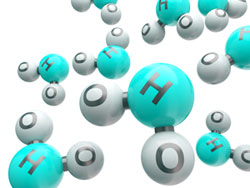Oxygen in drinking water supply
 Oxygen
gas is one of the most important elements collected from falling
rainwater. This dissolved oxygen is not the same as the oxygen in the
water molecule. Dissolved oxygen is present in all rainwater and surface
supplies due to contact with the atmosphere. Living organisms in lakes,
rivers, streams, and oceans need oxygen to survive therefore dissolved
oxygen is essential in an aquatic environment but unfortunately it is
not very abundant. While air consists of 21% oxygen, the oxygen content
in water is only 0.001%! Just how much dissolved oxygen can be found in a
water supply will depend on several factors:
Oxygen
gas is one of the most important elements collected from falling
rainwater. This dissolved oxygen is not the same as the oxygen in the
water molecule. Dissolved oxygen is present in all rainwater and surface
supplies due to contact with the atmosphere. Living organisms in lakes,
rivers, streams, and oceans need oxygen to survive therefore dissolved
oxygen is essential in an aquatic environment but unfortunately it is
not very abundant. While air consists of 21% oxygen, the oxygen content
in water is only 0.001%! Just how much dissolved oxygen can be found in a
water supply will depend on several factors:- Aeration of water - Under high pressure relatively large quantities of oxygen dissolve in water. When the pressure is reduced, a proportionate weight of the gas escapes (Henry's Law*).
- Mineral content of water - The amount of minerals in water affects its ability to dissolve oxygen. Distilled water can absorb more oxygen than well waters with higher mineral content. Obviously sea water, for this same reason, holds less dissolved oxygen than fresh water.
- Excess nutrients lead to a common problem known as an “algal bloom.” This causes an overproduction of algae, which limits sunlight reaching lower waters, and reduces dissolved oxygen. Plants cannot live without sunlight, and as a consequence they will die. The reduction of dissolved oxygen occurs as plants die and decay at the bottom of the water.
Contrary to the prevailing notion that oxygen-depleting reactions in the soil zone and in the aquifer rapidly reduce the dissolved oxygen content of recharge water to detection limits, 2 to 8 milligrams per liter of dissolved oxygen is present in water from a variety of deep (100 to 1000 meters) aquifers in Nevada, Arizona, and the hot springs of the folded Appalachians and Arkansas. Most of the waters sampled are several thousand to more than 10,000 years old, and some are 80 kilometers from their point of recharge.
Oxygen adds to the taste of water. For this reason a small amount of it is desirable in drinking water. We are all familiar with the "flat" taste which water often possesses after it has been standing in an open container for some time. The taste can be improved simply by shaking the water in a partially filled bottle. This reintroduced oxygen into the water will give it a more appealing taste. Despite this desirable feature, dissolved oxygen can be a source of serious trouble in a household water supply. The fact is that oxygen causes corrosion. In cold water, oxygen normally has little corrosive effect. In contrast, when the water is heated, the oxygen can cause serious corrosion problems.
A number of chemicals are used in industry to remove oxygen from a water supply. Sodium sulfite (Na2S03) is probably most widely used for this purpose. It reacts with oxygen at high temperatures to form sodium sulfate (Na2S04), in this way reducing the oxygen. There are a number of chemicals that react similarly with oxygen to effect its removal. The degree of success varies. For household purposes treatment is normally limited to the use of polyphosphates to coat the insides of water lines to protect the metal from contact with the oxygen.
*Henry's Law. The English chemist, William Henry, formulated a law regarding the effect of pressure on a gas. The law states: The weight of a gas that dissolves in any given liquid is directly proportional to the pressure, providing the temperature remains constant. If one gram of oxygen, for example, dissolves in 100 cubic centimeters of water at atmospheric pressure, two grams of oxygen will dissolve under twice the normal atmospheric pressure, providing there has been no change in temperature.
How do humans interfere with the amount of dissolved oxygen?
- Human intervention comes in the form of dams, human waste, fertilizer and agricultural waste.
- Dams slow the flow of water which reduces the amount of aeration and increases the temperature.
- Human waste carries a large amount of oxygen consuming bacteria. Raw sewage can spill into the waterway and introduce bacteria into the water that will use up large amounts of dissolved oxygen.
- Fertilizers create algae blooms and plants cannot live without sunlight. The reduction of plants cause less dissolved oxygen.
No comments:
Post a Comment